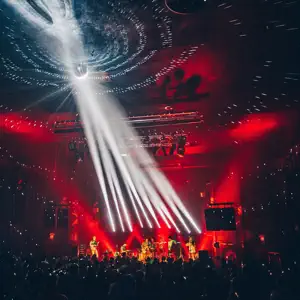


ORIGEN
Stillwater, NJ
Acerca de Railroad Earth
Railroad Earth emerged from the breakup of one of New Jersey's most popular bands, From Good Homes, in early 2001. Later that year, with appearances at some of the major summer festivals on the bluegrass circuit under their belt -- including the Telluride Bluegrass Festival, Grey Fox Bluegrass Festival, and High Sierra Music Festival -- Railroad Earth showed that their music could go well beyond the realm of traditional bluegrass to incorporate folk, Celtic, jazz, and rock music. Todd Sheaffer, the group's main songwriter and former lead singer of From Good Homes, stood at the forefront of the group's vision, and Railroad Earth began releasing albums within six months of the band's formation.
Railroad Earth's seeds were planted as far back as 1998, when violinist Timothy Carbone (Blue Sparks from Hell, Kings in Disguise) met film music supervisor Brian Ross, a former booking agent with Family Tree Agency, at the now-defunct Wetlands club in New York City. The two started a conversation about bluegrass music during a break in the evening's lineup. After keeping in touch for several months, the two hatched an idea to gather together professional musicians in New Jersey to play bluegrass at informal jam sessions. Meanwhile, Ross hired Carbone and Andy Goessling (also in Blue Sparks from Hell, Kings in Disguise) to play music for the film Big Eden. Sheaffer arrived at the bluegrass sessions in the fall of 2000 with some new songs, which the musicians rendered as bluegrass numbers.
All the musicians started to gather at the Shindig, an open-mike event sponsored by the Pocono Bluegrass Society. Informal jam sessions continued at Goessling's house, with multi-instrumentalist John Skehan (Bobby Syvarth Band) joining the other three musicians. Eventually, Ross approached the musicians about forming a band and performing as Railroad Earth. The new group secured its core members in Sheaffer (who handled vocals and acoustic guitar), Goessling (acoustic guitar, mandolin, banjo, penny whistle, saxophone), Carbone (violin, acoustic guitar), and session player John Skehan (mandolin, guitar, piano). Drummer/percussionist Carey Harmon (formerly with the Hour and Bobby Syvarth Band) and upright/electric bassist Dave Von Dollen completed the lineup in January 2001.
One month after forming, the bluegrass-rock group recorded a five-song demo at Mixolydian Studios in Lafayette, New Jersey. Four of those songs ("Head," "Black Bear," "Stillwater Getaway," and "Cold Water") were combined with six new songs recorded in April 2001 to form the band's debut CD, The Black Bear Sessions, which was released in June by BOS Music. Railroad Earth broadened their songwriting style during the remainder of 2001, carrying on the improvisational, multiple-genre tradition started by the Grateful Dead, String Cheese Incident, Phish, and Leftover Salmon. The group skated the edge of traditional bluegrass and the jam band tradition to produce an eclectic blend of folk, Celtic, jazz, and rock filtered through a bluegrass lens. A second album (and the band's first release for Sugar Hill), Bird in a House, followed in 2002, and producer Stewart Lerman joined Railroad Earth in the studio to record 2004's The Good Life. A live album named Elko followed in early 2006.
Railroad Earth toured heavily, but the band also found time to regularly return to the studio. In 2008, the guys released their fourth studio effort, Amen Corner, which doubled as their last recording with bassist Johnny Grubb, who had replaced Dave Von Dollen five years prior. The group drafted Andrew Altman as his replacement and hit the studio once again, this time to record 2010's self-titled Railroad Earth. After long periods of touring and some well-deserved time off, the band reentered the studio in 2013. In January of 2014, they re-emerged with Last of the Outlaws. ~ Robert Hicks
Railroad Earth's seeds were planted as far back as 1998, when violinist Timothy Carbone (Blue Sparks from Hell, Kings in Disguise) met film music supervisor Brian Ross, a former booking agent with Family Tree Agency, at the now-defunct Wetlands club in New York City. The two started a conversation about bluegrass music during a break in the evening's lineup. After keeping in touch for several months, the two hatched an idea to gather together professional musicians in New Jersey to play bluegrass at informal jam sessions. Meanwhile, Ross hired Carbone and Andy Goessling (also in Blue Sparks from Hell, Kings in Disguise) to play music for the film Big Eden. Sheaffer arrived at the bluegrass sessions in the fall of 2000 with some new songs, which the musicians rendered as bluegrass numbers.
All the musicians started to gather at the Shindig, an open-mike event sponsored by the Pocono Bluegrass Society. Informal jam sessions continued at Goessling's house, with multi-instrumentalist John Skehan (Bobby Syvarth Band) joining the other three musicians. Eventually, Ross approached the musicians about forming a band and performing as Railroad Earth. The new group secured its core members in Sheaffer (who handled vocals and acoustic guitar), Goessling (acoustic guitar, mandolin, banjo, penny whistle, saxophone), Carbone (violin, acoustic guitar), and session player John Skehan (mandolin, guitar, piano). Drummer/percussionist Carey Harmon (formerly with the Hour and Bobby Syvarth Band) and upright/electric bassist Dave Von Dollen completed the lineup in January 2001.
One month after forming, the bluegrass-rock group recorded a five-song demo at Mixolydian Studios in Lafayette, New Jersey. Four of those songs ("Head," "Black Bear," "Stillwater Getaway," and "Cold Water") were combined with six new songs recorded in April 2001 to form the band's debut CD, The Black Bear Sessions, which was released in June by BOS Music. Railroad Earth broadened their songwriting style during the remainder of 2001, carrying on the improvisational, multiple-genre tradition started by the Grateful Dead, String Cheese Incident, Phish, and Leftover Salmon. The group skated the edge of traditional bluegrass and the jam band tradition to produce an eclectic blend of folk, Celtic, jazz, and rock filtered through a bluegrass lens. A second album (and the band's first release for Sugar Hill), Bird in a House, followed in 2002, and producer Stewart Lerman joined Railroad Earth in the studio to record 2004's The Good Life. A live album named Elko followed in early 2006.
Railroad Earth toured heavily, but the band also found time to regularly return to the studio. In 2008, the guys released their fourth studio effort, Amen Corner, which doubled as their last recording with bassist Johnny Grubb, who had replaced Dave Von Dollen five years prior. The group drafted Andrew Altman as his replacement and hit the studio once again, this time to record 2010's self-titled Railroad Earth. After long periods of touring and some well-deserved time off, the band reentered the studio in 2013. In January of 2014, they re-emerged with Last of the Outlaws. ~ Robert Hicks
Canciones más vistas de
Railroad Earth en Abril
Top Artistas
Nosotros
Notas
